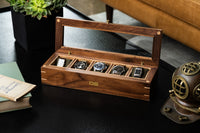Chances are high that the watch you’re currently wearing glows in the dark.
It might not — dress watches, for example, often lack some sort of luminescent material. But tool watches such as divers, chronographs, pilot’s watches, etc? Those things are lumed. And for good reason! What good is a watch dial that can’t be seen in the dark, after all?
There are several types of lume, and it’s worth knowing about and understanding each type. Contemporary watches use completely safe forms of photoluminescence or electroluminescence. But the watches of yesteryear? Those things are (cue Imagine Dragons) radioactive.
Radium

Radium was discovered by Marie and Pierre Curie in 1898. Beginning around the time of the First World War (1914-1918), watch and clock companies had employees apply luminous radium paint mixed with zinc sulfide to timepiece dials and hands. (Women were specifically employed under the belief that their smaller hands and deft touch would allow for a better, more even application on small parts such as watch indices.) During this time, though the adverse effects of radioactive radium were beginning to be known to these companies’ executives, precautions weren’t taken to protect the workers, who were even instructed to lick their paint brushes to straighten the bristles.

Of course, this was ludicrously hazardous, and many quickly began suffering the adverse effects of working with radium, including necrosis of the jaw, bone cancer, and more. In the mid-1920s, a group of women — who subsequently became known as the “Radium Girls” — successfully sued the United States Radium Corporation based in New Jersey, establishing a precedent for strict labor laws in the United States. Though radium continued to be used (in vastly diminished quantities) on watch and clock dials through the 1960s, workers were given adequate protection, and the practice of licking paint brushes was stopped. In 1968, use of the material was banned in favor of significantly less dangerous materials.
NOTE: Though there has been much debate on the subject over the years, the U.S. EPA advises that radium-painted watches do not pose a significant health risk to the wearer so long as they are intact. They should NOT, however, be taken apart and handled by the wearer. So, if you’ve got a cool watch from the 1910s-1960s, wear it in good health! (Maybe don’t lick the hands, though…)
Tritium and Promethium

Beginning in the 1960s, watch companies began using a paint containing tritium or promethium as alternatives to radium. As tritium decays, it emits beta radiation, which causes zinc sulfide in the paint to glow. This low-level beta radiation is much safer than radium’s gamma radiation, as it can’t penetrate human skin, and also has the added benefit of not degrading the phosphor in the paint, which will eventually cause it to stop glowing. Dials containing tritium — which was used on watches from the 1960s through the early 2000s — often have small ‘T’ marks flanking 6 o’clock. Some, such as those of military watches, feature an ‘H3’ enclosed in a circle. (Tritium is an isotope of hydrogen with one proton and two neutrons.)

NOTE: Tritium watches are perfectly safe to wear so long as they’re closed and intact. Tritium can be harmful if inhaled, ingested, or absorbed through open skin.
LumiNova, Super-LumiNova, and Others

Since the early 2000s, products such as LumiNova, which use photoluminescent pigments such as strontium aluminate, have been used to illuminate watch dials. As these are non-radioactive, they can be handled with ease and painted onto dials, hands, and indices. They glow in the dark by absorbing and re-emitting light, but unlike radioactive materials, they don’t glow for a particularly long time without being ‘charged’ in light. (Tritium-based paint, on the other hand, is ‘perpetually’ glowing, though often not as brightly as Super-LumiNova.)

Certain companies such as Rolex and Seiko use their own patented versions of this technology. (Rolex dubs its pigment ‘Chromalight,’ whereas Seiko calls its pigment ‘LumiBrite.’)
Tritium Tubes

Gallet X L.L. Bean Military Diver/Navigator - w/ applied Tritium gas tubes
Certain companies — mainly those that produce specialized ‘tool watches’ — use a contemporary form of tritium gas that is contained in tiny borosilicate glass vials, which are directly applied to watch dials and hands. These provide all the benefits of tritium illumination with none of the hazards inherent in the handling and application of tritium paint. Marathon Watch Company, Ball, and Luminox are well known for their use of this technology.
Electroluminescent Dials
If you had a Timex analog watch or G-SHOCK digital watch as a kid — or if you still do! — you’re more than likely familiar with this last category of ‘lume,’ which is that of electroluminescence. Essentially, a glass or plastic panel is coated in a phosphor and outfitted with an electric conductor. This panel is in turn mounted behind the watch dial; when the wearer pushes a button on the watch, an eclectic current flows through the panel, which reacts and glows, illuminating the dial.
The Bottom Line
While one should exercise caution with pre-1960s watches — and be sure not to take them apart or handle the dial — the general consensus is that it’s safe to wear them. Tritium-dialed watches are safe to wear under the same conditions, and much safer than radium-dialed watches. Contemporary Super-LumiNova (or similar) watches pose zero health threat whatsoever, and provided one doesn’t break the tiny borosilicate glass vials on a tritium tube-equipped watch, these are perfectly safe as well.












